Pandora FMS means flexibility to work with third party applications.
There are more than eight hundred pages of documentation for Pandora FMS. The science – and art, I think – of monitoring is very extensive. The needs of a large company are different from those of a medium or small organization. But even two large companies are not the same and their needs may be totally different. Today we will discuss BMC Remedyforce plugin, an Enterprise integration in Pandora FMS, but to understand the present, it is always good advice to take a look (no more) in the rear view mirror.
However, we are going to stay in the present century. For those who still do not know or have no notion, Pandora FMS Enterprise gets along with two great tools: Pandora RC and Pandora ITSM.
Pandora RC allows remote connection and inventory in a simple way, by itself and without Pandora FMS. I recommend it as an introduction to monitoring, as it presents basic but important options. Together with Pandora FMS, it is when the whole being more than the sum of the parts is fulfilled.
In the case of Pandora ITSM, we are already talking about a robust product for handling issues, but wait because there’s more. With Pandora ITSM you can create a knowledge base and turn the experience of employees, users and/or customers (each company decides how far to go) into inheritance for future personnel who start working. To be more specific, I am talking about the Human Readable Knowledge Base.
And of course, it can be integrated with Pandora FMS… and with many other software products.
What does all this have to do with BMC Remedyforce? We’ll see.
Interoperability
Interoperability is known as the ability of two or more systems or components to exchange information and use the information exchanged. Like any theoretical concept, it is easier said than done.
For instance, a “plain text file” is only really plain if it contains only 7-bit characters according to American Standard Code for Information Interchange… better known as ASCII, does this last one ring a bell? We will see later why it is important, but for now, let’s say yes, we skip books and documents, hundreds of them, and assume that all programmers have already agreed that sharing and speaking under certain conditions is a must… Let’s delve deeper and see what an API is.
Application Programming Interface (API)
Let’s put into practice what a Knowledge Base is: in this blog we have published excellent articles and in 2019 one of my colleagues wrote a very good one about it. There you will also have an introduction to Pandora FMS API. Read, have coffee and come back, this is going to get good with a specific technology that Linus Torvalds absolutely hates…
Extensible Markup Language (XML)
“[XML] is probably the worst format ever designed… It doesn’t really scale as a file format, and overall it’s a complete mess.”.
Linus Torvalds, March 6, 2014.
We already know about the enfant terrible personality from the creator of the Linux kernel and it has been several years since he expressed his opinion about XML (and hopefully he changed his mind).
XML is a markup language for encoding documents, developed by W3C as a subset of the Standard Generalized Markup Language (SGML). Although it was conceived to be easily readable by both machines and people, as we see, some do not find it that way. Earlier I spoke of “plain text” and here this takes on special importance: XML includes mechanisms to specify the encoding of UNICODE characters, and UTF-8 is generally used for this.
I tell you that the “secret” to dealing with XML is to program with libraries that take care of it; we will seldom have to see or read its content. In Pandora FMS, there is the format used to communicate with the Tentacle protocol between the different components; the Software Agents, more than anything else, originate lots of material.
The important thing about XML is that it allows you to add more information than that you had previously agreed, that is, it can be easily extended. But do not mistake freedom with debauchery: XML contemplates Document Type Definition (XML DTD) which is a pattern that each sent message must meet, there should be no excess or lack of information. That is why within the protocol that you make you must include messages precisely to notify of new XML DTDs and from when they will be implemented, among other aspects. So let’s go up one more step in knowledge: SOAP.
Simple Object Access Protocol (SOAP)
SOAP arises from the need to base communication between different systems regardless of their operating system or platform. Yes, you guessed it, it uses XML for sending data and information and is currently recommended by the WWW Consortium or World Wide Web Consortium (W3C). Like XML, SOAP can be extended easily and until today it has established extensions, some are:
WS-Addressing.
WS-Atomic Transaction.
WS-Coordination.
WS-Federation.
WS-Policy.
WS-Reliable Messaging.
WS-Remote Portlets.
WS-Security.
SOAP is used by many APIs, like it is the case of BMC Remedyforce, but it is not mandatory at all. Pandora FMS has its own public protocol that is transmitted by HTTPS (recommended) and many SOAPs also use HTTP as transport, although this is not mandatory at all. SOAP is even used over email, and there are many more aspects. For simplicity I just add that a SOAP message must contain an envelope (mandatory), a header(optional), a body and a fault section for error handling .
This is more than enough to present the BMC Remedyforce plugin, an integration with Pandora FMS.
BMC Remedyforce plugin
As discussed at the beginning of this article, BMC Remedyforce also handles incidences for tickets and Pandora FMS for its flexible alert system can communicate through SOAP (in Perl language) with BMC Remedyforce. You can even go further and receive answers but you better make it simple.
I must emphasize that what has to do with the Enterprise version is the BMC Remedyforce connector, not the feature itself. For this reason, do not take the example procedure at face value, or write in the comments that I made this or that mistake (don’t miss the opportunity of sending questions or suggestions, even greetings are welcomed). Of course, it serves as an example for alert creation and management in Pandora FMS.
First, I remind you that recently Pandora FMS created a new download page and it has also simplified its Cloud installation. Try it, and if you want more you can get a free demo for 30 days and thus have access to many professional plugins from the Enterprise version.
“New Licenses in Pandora FMS. Pandora FMS LITE ”
Preliminary for BMC Remedyforce
A manifest based on Web Services Description Language or simply WSDL must be generated by BMC Remedyforce. This element allows us to know the commands and features of the SOAP that will be used. I personally assimilate it as an XML DTD, not as a strict normative but as informative.
From Pandora FMS libraries you can download the connector and the according documentation. Once unzipped and installed, you can, along with your user credentials and the XML-generated WSDL, manage the infrastructure objects used in BMC Remedyforce.
Alerts in Pandora FMS

First create an alert command and it will be configured as follows:
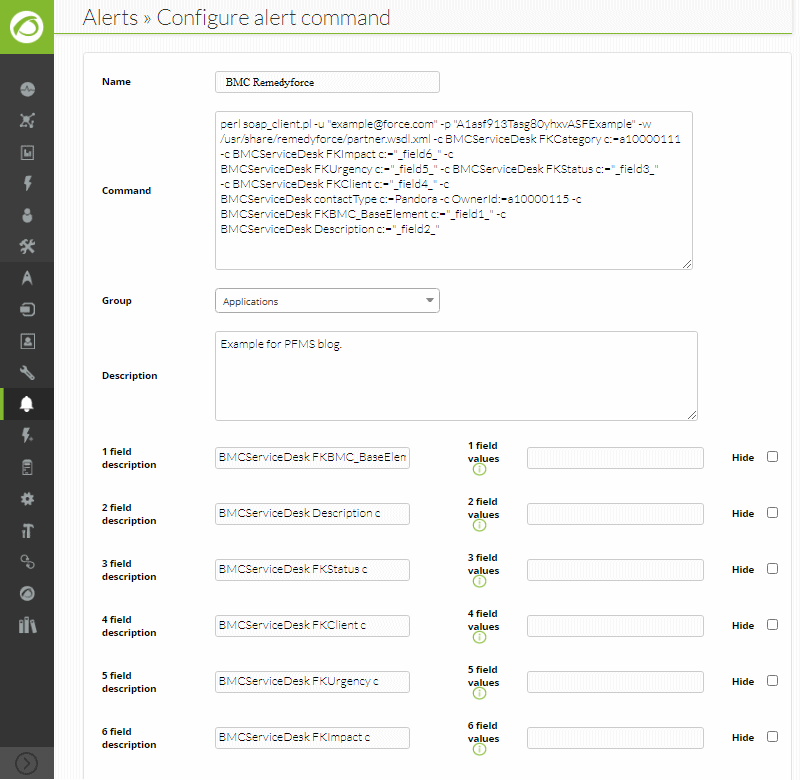
The complete instructions are (usually) in Pandora FMS documentation, with all details.
The next step is to create an alert action. Actions are the components of the alerts in which a command is related to the generic variables, for the example in BMC Remedyforce, they are the first six fields. Actions allow defining how to launch the command.
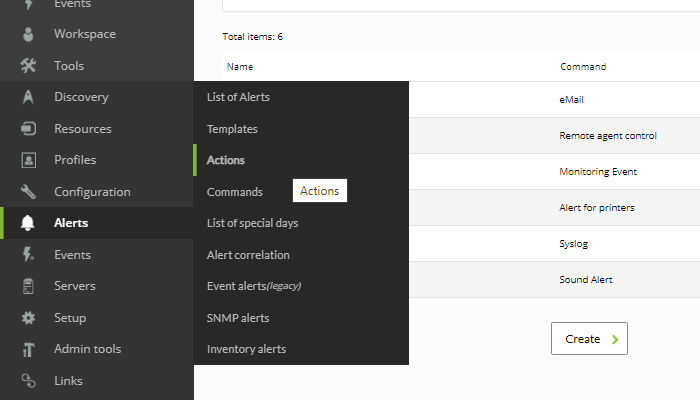
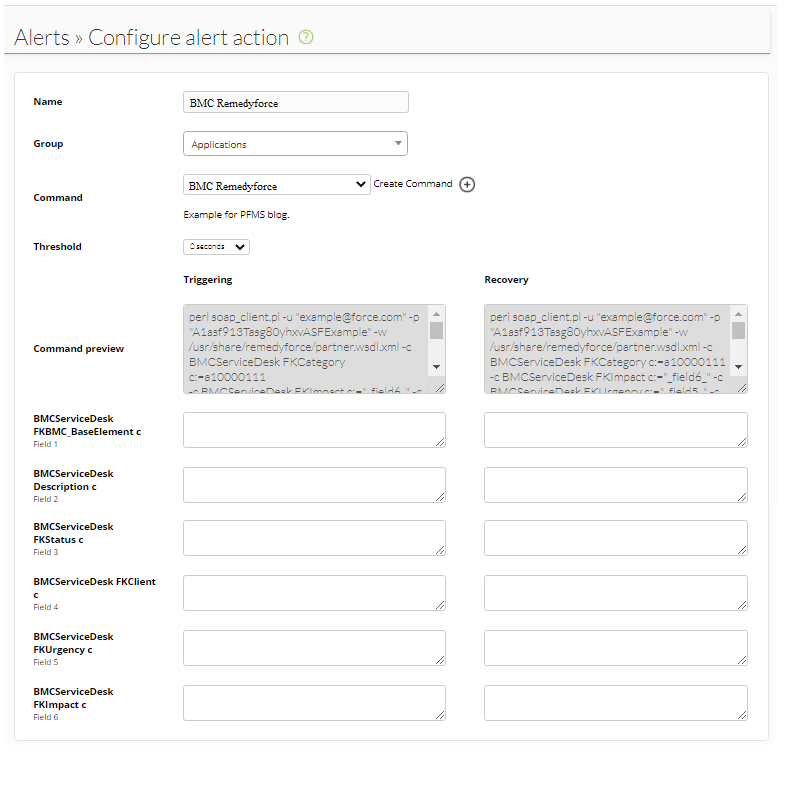
Once the command and action have been defined, it can be used in any alert for Pandora FMS to send and start a ticket in BMC Remedyforce.

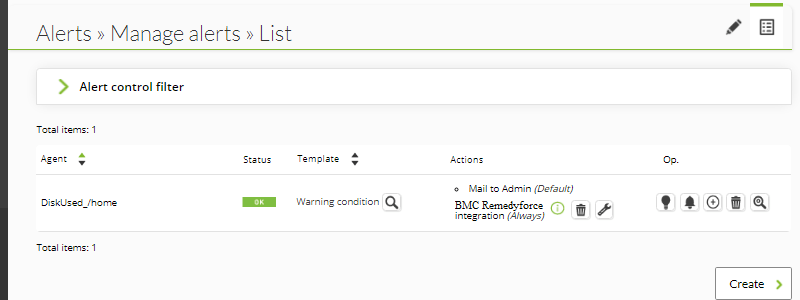
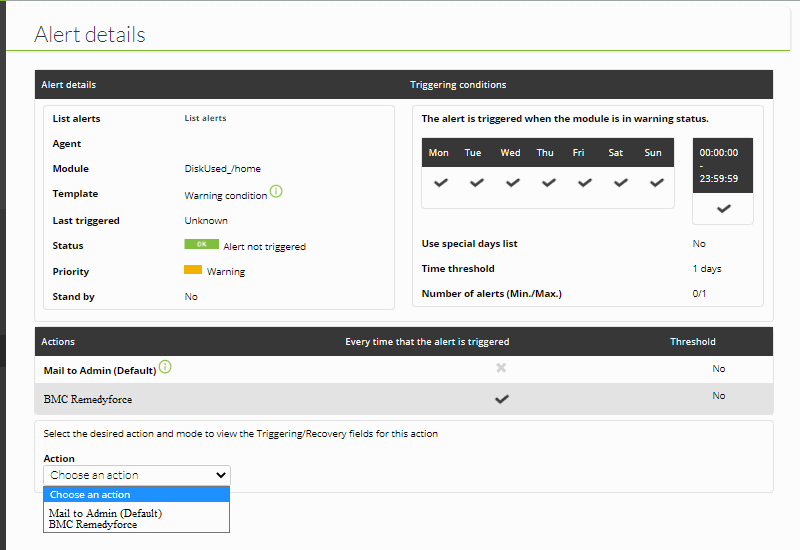
All you have left is for events to take place and trigger an alarm which sends an incidence record to the BMC Remedyforce plugin. At this point, it is time to contact your BMC Remedyforce staff members. These staff, in addition to the Home tab in BMC Remedyforce by default, have the Remedyforce Console tab. This tab shows the information about Incidences where Pandora FMS requests should arrive.
Before finishing, remember Pandora FMS is a flexible monitoring software, capable of monitoring devices, infrastructures, applications, services and business processes.
Would you like to find out more about what Pandora FMS can offer you? Find out clicking here: https://pandorafms.com
If you have more than 100 devices to monitor, you may contact us through the form: https://pandorafms.com/contact/
Also, remember that if your monitoring needs are more limited, you have Pandora FMS OpenSource version available. Learn more information here: https://pandorafms.org/
Do not hesitate to send us your questions. Pandora FMS team will be happy to help you!

Programmer since 1993 at KS7000.net.ve (since 2014 free software solutions for commercial pharmacies in Venezuela). He writes regularly for Pandora FMS and offers advice on the forum . He is also an enthusiastic contributor to Wikipedia and Wikidata. He crushes iron in gyms and when he can, he also exercises cycling. Science fiction fan. Programmer since 1993 in KS7000.net.ve (since 2014 free software solutions for commercial pharmacies in Venezuela). He writes regularly for Pandora FMS and offers advice in the forum. Also an enthusiastic contributor to Wikipedia and Wikidata. He crusher of irons in gyms and when he can he exercises in cycling as well. Science fiction fan.
















